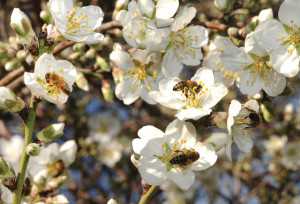Top 10 Ways To Help Save The Bees

(Photo credit: Randy Oliver)
Editor’s Note: Randy Oliver, a beekeeper in Grass Valley, CA, hosts the website ScientificBeekeeping.com
Here are some ways that growers can help protect and save pollinators on your orchard from a beekeeper. For more from the perspective of a beekeeper, read Oliver’s “Beekeeper Asks Growers To ‘Help Me Save My Bees.’”
- Leave a part of your land untilled and not burned bare with herbicides to provide pollinator-friendly forage for bees and other wildlife. Preserve hedgerows, woodlots, and pasture land. Encourage other landowners to do the same.
- Bees need water; don’t pollute ditches and runoff with pesticides.
- Practice IPM; don’t use pesticides except as a last resort.
- Since bees are only interested in flowers, their most intense pesticide exposure occurs from products sprayed on the bloom. If possible, spray before or after bloom. This should be obvious if you’re paying for bees, but it also applies to other crops if hungry bees are working your fields.
- If you must spray during bloom, spray after sunset, so that the insecticide can dry overnight before the bees hit the flowers in the morning. If you must spray during bloom, use the insecticides that are least toxic to bees — read the label to see whether it says “highly toxic to honey bees.”
- Some formulations are more toxic to pollinators. Avoid dusts and microencapsulated insecticides, as well as insecticides with long residual action. Remember that insecticide residual activity may be extended in cool or damp conditions.
- Be especially careful with systemic insecticides, which can be transported by the plant into the nectar and pollen, if applied before bloom.
- Some fungicides and spray adjuvants are toxic to bees, even if the label doesn’t say so. Again, avoid spraying during bloom unless absolutely necessary.
- Avoid pesticide drift onto adjacent crops or weedy areas which pollinators may be working. Look to see whether bees are working flowering weeds in the orchard understory; if so, mow them before spraying.
- Don’t expect the beekeeper to be able to cover or move his bees to safety at the drop of a hat — a commercial beekeeper with 10,000 hives placed may receive a dozen spray notices a day, and his trucks may be thousands of miles away. It’s the pesticide applicator’s responsibility not to kill pollinators.
0
1
5
Top 10 Ways To Help Save The Bees




